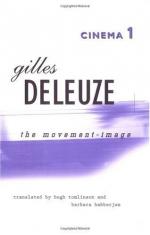
|
| Name: _________________________ | Period: ___________________ |
This test consists of 15 multiple choice questions and 5 short answer questions.
Multiple Choice Questions
1. What kind of form did Ford use predominately?
(a) Short.
(b) Medium.
(c) Small.
(d) Large.
2. Movement from action to situation is an example of which of the following?
(a) Impulse-image.
(b) Action-image.
(c) Reasoning-image.
(d) Perception-image.
3. Who directed "Heaven and Hell"?
(a) Eisenstein.
(b) Kurosawa.
(c) Dostoevsky.
(d) Mizoguchi.
4. Who does Deleuze credit as extending the realm of cinema to include the audience?
(a) Hitchcock.
(b) Langeon.
(c) Marx Brothers.
(d) Laurel and Hardy.
5. What is the second pole of action-image?
(a) Behavior.
(b) Genetics.
(c) Binomial.
(d) Firstness.
6. Deleuze believes that realism of a film should be inferred from which of the following?
(a) Setting.
(b) Environment.
(c) Writing.
(d) Acting.
7. According to Deleuze, what was Fuller unable to break?
(a) Action-image.
(b) Impulse-image.
(c) Affective-image.
(d) Perception-image.
8. What is the name of the form in which things move from action to situation.
(a) ASA.
(b) SAS.
(c) SAA.
(d) AAS.
9. What is the fourth of five traits of the new image, as designated by Deleuze?
(a) Condemned consciousness.
(b) Firstness.
(c) Cliche consciousness.
(d) Large form.
10. A complex entity can be which of the following?
(a) Person, thing, character.
(b) An item used off screen.
(c) Character or person.
(d) Characters who don't come on-screen.
11. What word does Pierce associate with "Firstness"?
(a) Voyage.
(b) Mental.
(c) Affection.
(d) Action.
12. Which film is used as an example by the filmmaker Snow?
(a) The Hills.
(b) The Central Region.
(c) The San Joaquin Valley.
(d) The City.
13. The construction of any-space-whatevers allow what to be used, according to Deleuze?
(a) Medium shots.
(b) Shadow.
(c) Organic school.
(d) Expressionism.
14. Who is the second man Deleuze calls a cinematic master of realism?
(a) Fuller.
(b) Bunuel.
(c) Bergson.
(d) Mitry.
15. The formula ASA brings out the distance between which of the following?
(a) Images.
(b) Indexes.
(c) Actions.
(d) Situations.
Short Answer Questions
1. What are the images used from which to deduce a situation?
2. What is the name of Ford's film used as an example of the Western genre?
3. What word does Pierce associate with "Thirdness"?
4. Deleuze believes that Bunuel's work is characterized by which quality?
5. Eisenstein used a foggy ship silhouette as which of the following?
|
This section contains 328 words (approx. 2 pages at 300 words per page) |

|




